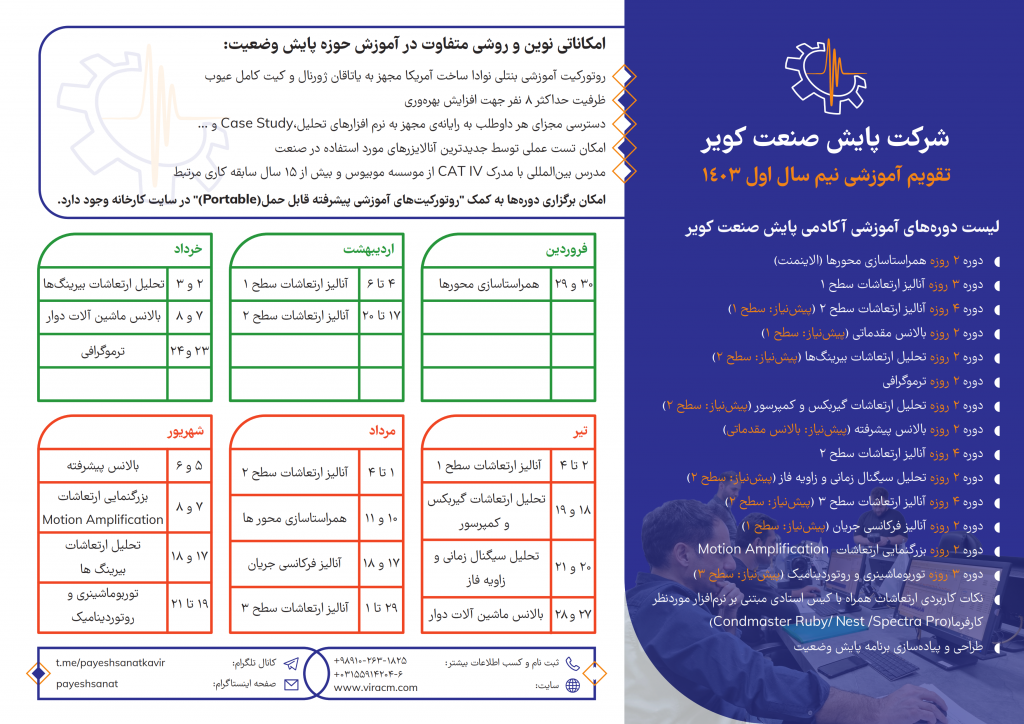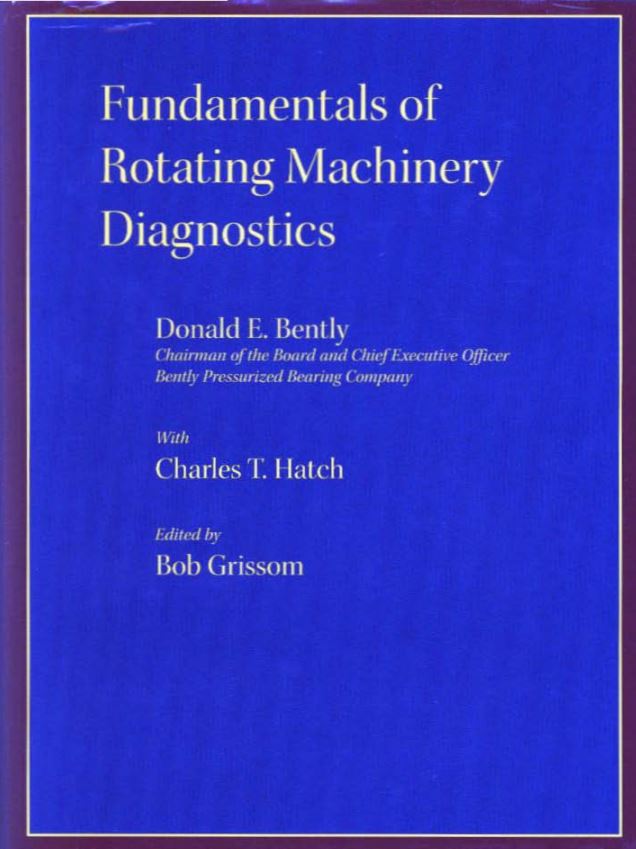Register Link for PAYESH SANAT KAVIR Courses
ثبت نام در دورههای پایش صنعت کویر
Training with testing AND Analysis
تقویم آموزشی دوره های داخلی
Payesh Sanat Kavir Course Calendar

Register Link for PAYESH SANAT KAVIR Courses
ثبت نام در دورههای پایش صنعت کویر
Training with testing AND Analysis
تقویم آموزشی دوره های داخلی
Payesh Sanat Kavir Course Calendar


This reference and its contents are one of the best references for turbomachinery courses
Table of Content
Vibration
| The Basic Vibration Signal | |
| Frequency | |
| Amplitude | |
| Displacement, Velocity, and Acceleration | |
| The Vibration of Machines | |
| Rotation and Precession | |
| Free Vibration | |
| Forced Vibration | |
| Resonance | |
| Self-Excited Vibration | |
| Summary |
Phase
| What is Phase | |
| Why Is Phase Important | |
| The Keyphasor Event | |
| Phase Measurement | |
| Absolute Phase | |
| Relative Phase | |
| Differential Phase | |
| Summary |
Vibration Vectors
| Unfiltered Vibration | |
| Filtering and the Vibration Vector | |
| Working with Vibration Vectors | |
| The Slow Roll Vector | |
| Summary |
Timebase Plots
| The Structure of a Timebase Plot | |
| The Keyphasor Mark | |
| Compensation of Timebase Plots | |
| Information Contained in the Timebase Plot | |
| Summary |
The Orbit
| The Construction of the Orbit | |
| The Keyphasor Mark | |
| Compensation of Orbits | |
| Information Contained in the Orbit | |
| The Orbit/Timebase Plot | |
| Summary |
Average Shaft Centerline Plots
| The Construction of the Average Shaft Centerline Plot | |
| Information Contained in the Average Shaft Centerline Plot | |
| The Complete Picture: Orbit Plus Average Shaft Centerline Position | |
| Summary |
Polar, Bode, and APHT Plots
| The Structure of Polar and Bode Plots | |
| Slow Roll Compensation | |
| Information Contained in Polar and Bode Plots | |
| APHT Plots | |
| Acceptance Region Plots | |
| Summary | |
| References |
Half and Full Spectrum Plots
| The Half Spectrum Plot | |
| Technical Issues | |
| The Full Spectrum | |
| Spectrum Cascade Plots | |
| Spectrum Waterfall Plots | |
| Summary |
The Rotor System Model
| Introduction to Modeling | |
| Assumptions | |
| The Coordinate System and Position Vector | |
| Lambda (A): A Model of Fluid Circulation | |
| Fluid-film Bearing Forces and Stiffnesses | |
| Other Sources of Spring Stiffness | |
| The Damping Force | |
| The Perturbation Force | |
| The Free Body Diagram | |
| The Equation of Motion | |
| Solution of the Equation of Motion | |
| Nonsynchronous Dynamic Stiffness | |
| Amplitude and Phase of the Vibration Response | |
| The Attitude Angle: Rotor Response to a Static Radial Load | |
| Synchronous Rotor Response | |
| Synchronous Dynamic Stiffness | |
| Predicted Rotor Vibration | |
| Nonlinearities | |
| The Benefits and Limitations of the Simple Model | |
| Extending the Simple Model | |
| Summary | |
| References |
Dynamic Stiffness and Rotor Behavior
| What Is Dynamic Stiffness | |
| Rotor Parameters and Dynamic Stiffness | |
| Synchronous Rotor Behavior | |
| Synchronous Behavior Below Resonance | |
| Synchronous Behavior At The Balance Resonance | |
| How Changes In Dynamic Stiffness Affect Vibration | |
| Summary |
Modes of Vibration
| Mode Shapes | |
| Forced Mode Shapes and Multimode Response | |
| Modal Parameters | |
| The Measurement of Mode Shape | |
| Mode Identification Probes | |
| Summary |
Anisotropic Stiffness
| Anisotropic Stiffness | |
| Split Resonances | |
| Measured Rotor Behavior and Anisotropic Stiffness | |
| Probe Mounting Orientation and Measured Response | |
| Virtual Probe Rotation | |
| Forward and Reverse Vectors | |
| Summary | |
| References |
Rotor Stability Analysis: The Root Locus
| What is Stability | |
| Stability and Dynamic Stiffness | |
| Stability Analysis | |
| State-Space Formulation of the Eigenvalue Problem | |
| The Root Locus Plot | |
| The Root Locus and Amplification Factors | |
| Parameter Variation and the Root Locus | |
| The Root Locus of Anisotropic and Multimode Systems | |
| The Root Locus and the Logarithmic Decrement | |
| The Root Locus and the Campbell Diagram | |
| Root Locus Analysis of Machine Stability Problems | |
| Summary | |
| References |
Torsional and Axial Vibration
| The Torsional View of the Rotor | |
| Static and Dynamic Torsional Response | |
| Torsional/Radial Cross Coupling | |
| Torsional Vibration Measurement | |
| Axial Vibration | |
| Summary | |
| References |
Basic Balancing of Rotor Systems
| Unbalance and Rotor Response | |
| Vibration Transducers And Balancing | |
| Balancing Methodology | |
| Locating the Heavy Spot Using a Polar Plot | |
| Using Polar Plots Of Velocity and Acceleration Data | |
| Selecting the Calibration Weight | |
| Relating Balance Ring Location To Polar Plot Location | |
| Single Plane Balancing With Calibration Weights | |
| Weight Splitting | |
| The Influence Vector | |
| The Influence Vector And Dynamic Stiffness | |
| Multiple Modes And Multiplane Balancing | |
| Multiplane Balancing With Influence Vectors | |
| How Balancing Can Go Wrong | |
| Summary | |
| References |
Malfunctions
Introduction to Malfunctions
| What is a Malfunction | |
| Detection of Malfunctions |
Unbalance
| Rotor System Vibration Due To Unbalance | |
| Stress and Damage | |
| Other Things That Can Look Like Unbalance | |
| Runout | |
| Rotor Bow | |
| Electrical Noise in the Transducer System | |
| Coupling Problems | |
| Shaft Crack | |
| Loose Part or Debris | |
| Rotor Dynamic Effects of Rotor Bow | |
| Thermal Bow During Operation | |
| Diagnosing Rotor Bow | |
| Removing Rotor Bow | |
| Summary | |
| References |
High Radial Loads and Misalignment
| Static Radial Loads | |
| What Is Misalignment | |
| Temperature Changes and Alignment | |
| Causes of Misalignment | |
| Symptoms of High Radial Load and Misalignment | |
| Bearing Temperature | |
| Vibration Changes | |
| Stresses and Wear | |
| Abnormal Average Shaft Centerline Position | |
| Orbit Shape | |
| Rub | |
| Fluid-induced Instability | |
| Summary |
Rub and Looseness
| Rub and Looseness | |
| Partial Radial Rub | |
| Full Annular Rub | |
| Rub-Induced Forces and Spring Stiffness Changes | |
| Rub and Steady State 1X Vibration | |
| Rub and IX Vibration During Resonance | |
| Subsynchronous Vibration | |
| Symptoms of Rub | |
| Other Malfunctions with Similar Symptom | |
| Summary |
Fluid-Induced Instability
| The Cause of Fluid-Induced Instability | |
| Modes of Instability: Whirl and Whip | |
| Symptoms of Fluid-induced Instability | |
| Other Malfunctions That Can Produce Similar Symptoms | |
| Locating the Source of Instability | |
| Eliminating Fluid-Induced Instability | |
| Summary |
Externally Pressurized Bearings and Machinery Diagnostics
| Types of Bearings | |
| Internally Pressurized Fluid-Film Bearings | |
| Externally Pressurized Fluid-Film Bearings | |
| Stiffness and Modal Damping in Fluid-Film Bearings | |
| Variable Stiffness in Internally Pressurized Bearings | |
| Variable Stiffness in Externally Pressurized Bearings | |
| Rotor Dynamic Implication of Variable Stiffness Bearings | |
| Diagnostic Implications of Variable Stiffness Bearings | |
| Summary | |
| References |
Shaft Cracks
| Crack Initiation, Growth, and Fracture | |
| Reduction of Shaft Stiffness Due To a Crack | |
| Shaft Asymmetry and 2X Vibration | |
| The First Rule of Crack Detection (1X) | |
| The Second Rule of Crack Detection (2X) | |
| Other Malfunctions That Produce IX Vibration Changes | |
| Other Malfunctions That Produce 2X Vibration | |
| Design and Operating Recommendations | |
| Monitoring Recommendations | |
| Summary |
Appendix
| A1 Phase Measurement Conventions The Instrumentation Convention The Mathematical Convention Converting Between The Two Conventions Phase on Bode and APHT Plots | |
| A2 Filtered Orbit and Timebase Synthesis Timebase Synthesis Orbit Synthesis | |
| A3 The Origin Of the Tangential Stiffness Term Modeling the Pressure Wedge Transformation to Stationary Coordinates Reference | |
| A4 SAF Calculation Peak Ratio Method Phase Slope Method Polar Plot Method | |
| A5 Vector Transforms Virtual Probe Rotation The Forward and Reverse Transform and Full Spectrum References | |
| A7 Units of Measurement Metric/US Customary Unit Conversions Unit Prefixes Unit Abbreviations Force, Weight. and Mass in the US Customary System | |
| AS Nomenclature Upper case Homan Lower case Roman Upper case Greek Lower case Greek |